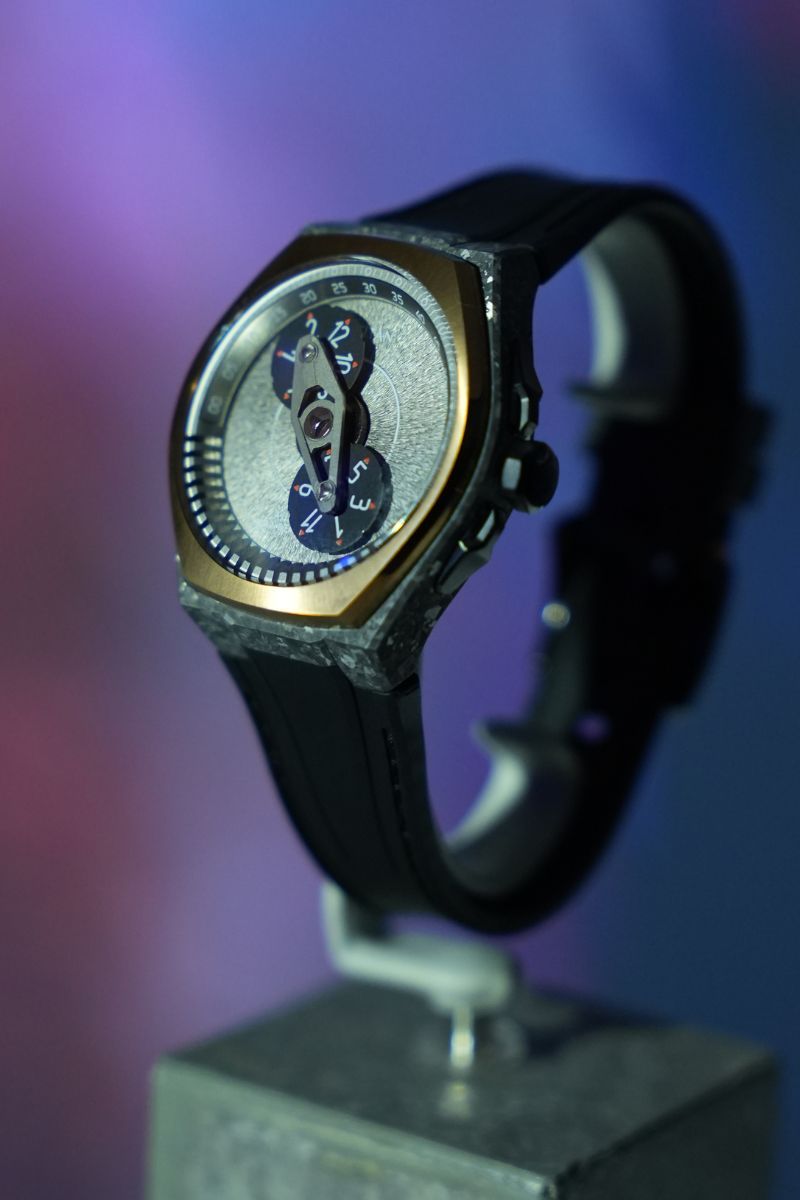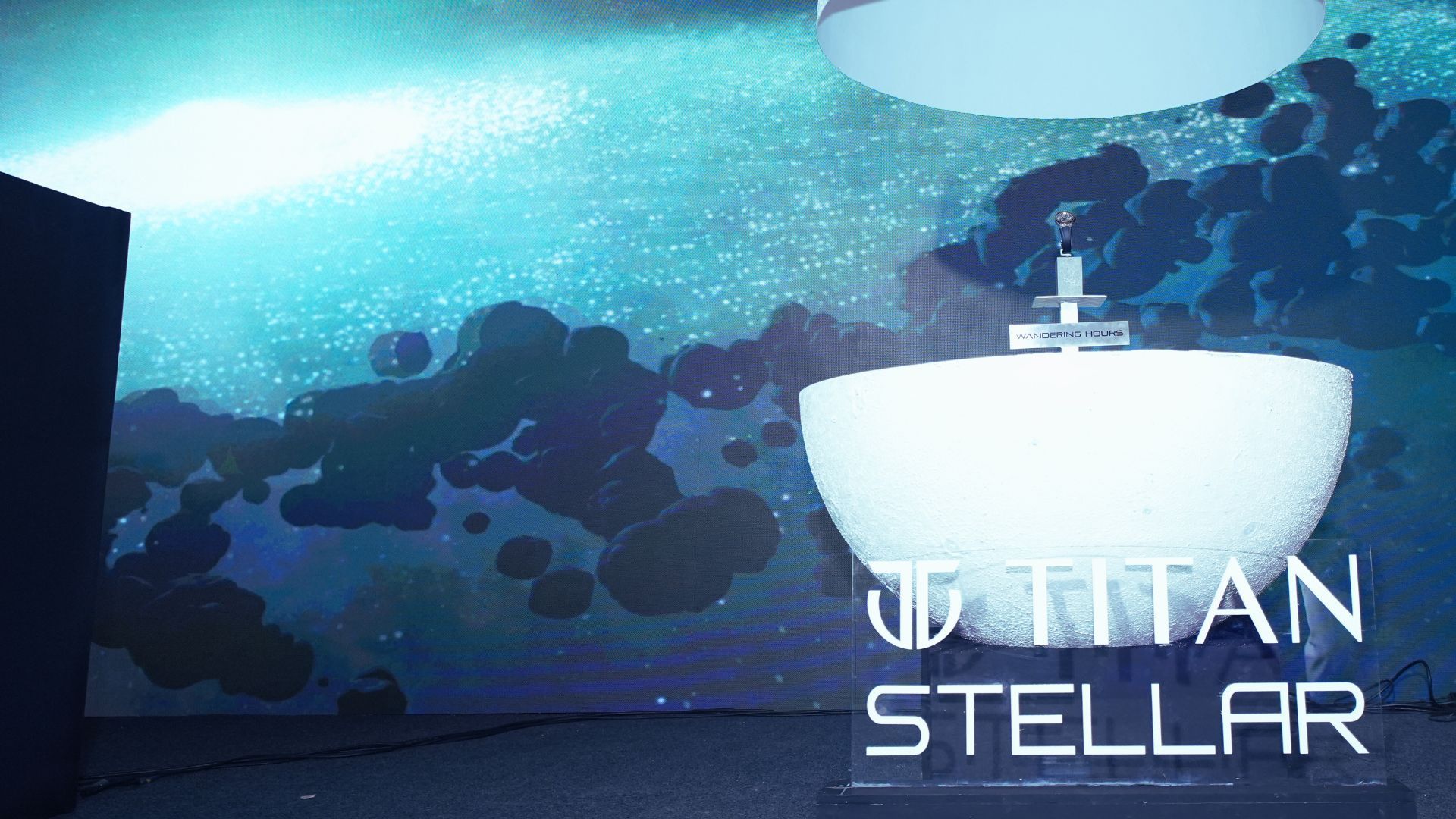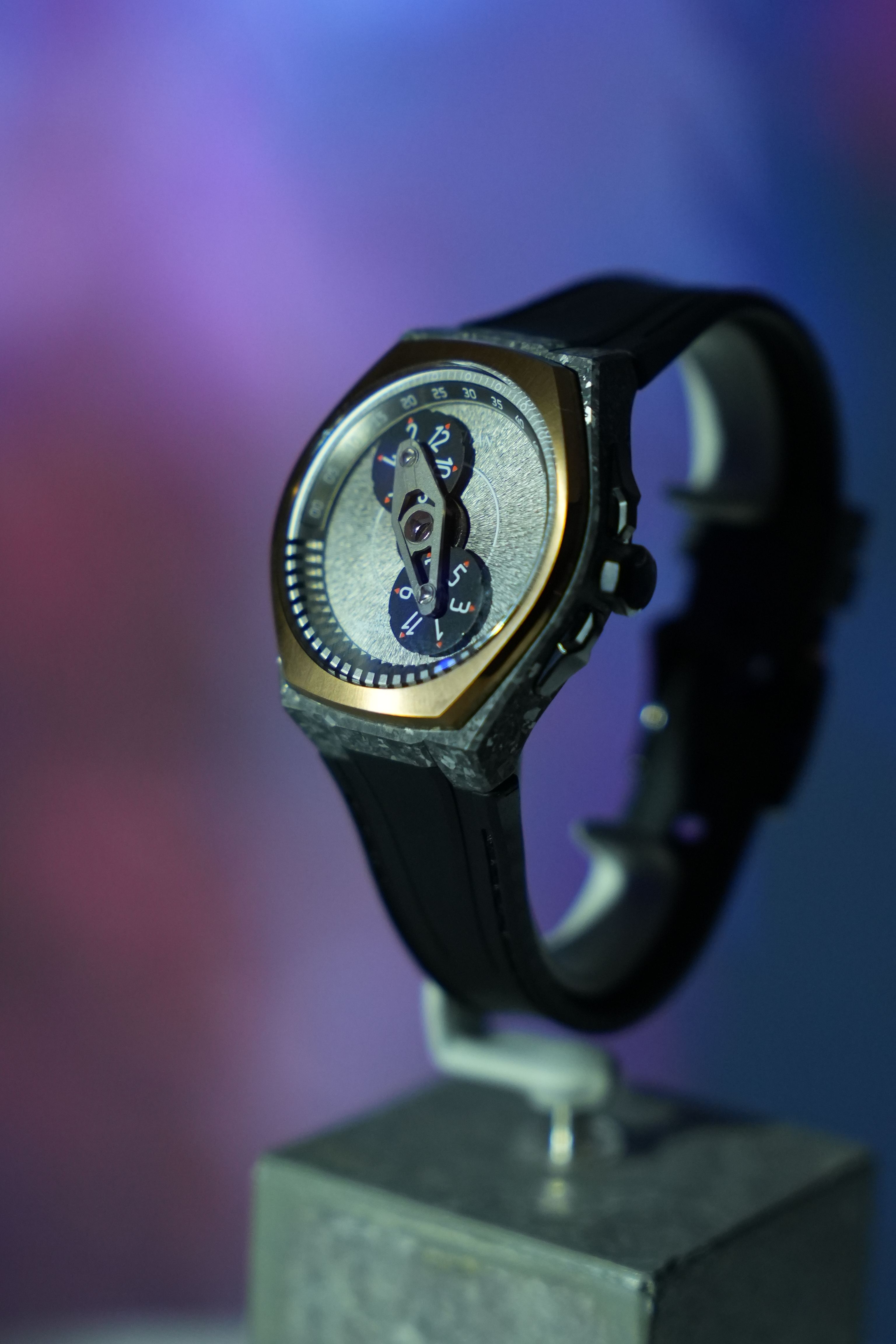When Titan unveiled Stellar 1.0 in 2022, it felt like a quiet rupture in the brand’s design language. Here was an Indian watchmaker leaning away from its reputation for accessible elegance and towards a new archetype — the explorer. The first Stellars borrowed their visual identity from the most distant of inspirations: black holes, supernovas, and galactic voids, reflecting a post-pandemic fascination with the skies. More importantly, they introduced a narrative thread Titan had rarely pursued before — that horology could be as much about storytelling as function.
That thread grew bolder in Stellar 2.0, unveiled the following year. The collection expanded into 13 references, each using unusual materials such as Swedish meteorite, Grade 5 titanium, and semi-precious stones like Jasper and Tiger Eye . The watches were both cosmic in theme and tactile in execution, with dials that shimmered like starlit skies. As Head of Design Mahendra Chauhan explained then, it was about moving Titan from the “lover’s archetype” to the “explorer’s archetype” — positioning the brand not only in India’s premium space but also on a global stage, as its GPHG debut signalled .
Fast forward to October 9th, 2025, when Titan gathered press, collectors, and enthusiasts at Bastian at the Top in Mumbai for the unveiling of Stellar 3.0 . The event marked not just a seasonal launch but what Titan calls “a new chapter in Indian watchmaking.” The nine-piece collection introduces three limited editions, with the Wandering Hours stealing the spotlight — the first time this complication has been attempted by an Indian brand. Its twin satellite discs, set in crystallised titanium and orbiting across a brushed copper bezel, glide across the dial like moons in transit, offering both mechanical intrigue and visual theatre.
The other limited editions continue this celestial motif. The Ice Meteorite returns for a third outing, this time in an icy blue-plated dial cut from a 120,000-year-old Muonionalusta meteorite, while the Aurora Caelum frames a glowing green dial reminiscent of the northern lights inside a titanium Grade 5 case. Together, the three pieces embody Stellar’s design philosophy: celestial phenomena, rare materials, and high horological functions. For Titan, they are not only collector’s items but also an audacious claim to space in the global conversation on horology—something we touched on as we spoke with Chauhan ahead of the launch.
An architecture student turned product designer, he has spent the last few years pushing Titan into uncharted territory — from experimenting with rare materials in Stellar 2.0 to orchestrating India’s first Wandering Hours complication in 3.0. For Chauhan, each Stellar chapter is less about checking off technical milestones and more about crafting stories that resonate with emotion as much as engineering. It’s a philosophy that has shaped Titan’s boldest projects, from the Jalsa collaboration to their recent tourbillon, and one that positions him as not just a designer but as a cultural custodian of what Indian horology could be.
With Stellar 3.0 fresh off its debut, we sat down with Chauhan to trace the evolution of the collection, and to understand what it means to build watches that aim not just for wrists, but for the imagination. Excerpts:

Here’s the Q&A draft, cleaned up from your transcript with answers kept as verbatim as possible. I’ve only adjusted grammar and flow lightly where needed so it reads smoothly but still preserves Mahendra Chauhan’s voice.
Stellar has always felt like a journey. From 1.0 through 2.0 and now 3.0, what’s the bigger picture for you?
Everything started with Stellar 1.0, which was just the genesis. That was during COVID or just after, when we realised the world was gazing towards the sky more often. Stellar 1 was about black holes and supernovas. Stellar 2.0 was about elevating that vision using rare materials like Grade 5 titanium, Jasper, aventurine, and meteorite — not for novelty but because they connected directly to the imagery of galaxies. With Stellar 3.0, we’ve taken the game one level up, with complications that aren’t just cold mechanisms but designed to create emotional desire. This is where Titan really steps into horology.
When you began the design phase for 3.0, what ideas came to the surface first? Was it gradual, or did you already know what you wanted to achieve?
Most of our design journeys are very organic. We don’t start with a fixed end goal but with trust in the process. For Stellar 3, the base platform was already set, so the team explored multiple concepts over 14–15 months. Some ideas came quickly, while others like the Wandering Hour took 16–18 months just at the prototyping stage. Everything came together very organically, with constant review sessions, market insights, and refinements. The beautiful outcome is always part of that process.
The Wandering Hours is the headline piece. Why choose this complication, and what challenges did you face bringing it to life?
Our complications are never just mechanisms; they always begin with an emotional story. Wandering Hours is not new — it goes back to 17th-century pocket watches and early Swiss brands. But we wanted to reinterpret it with a cosmic narrative. The rotating discs reminded us of satellites orbiting Earth. Translating that into an in-house movement brought huge challenges — gear chain tolerances, torque management for the sapphire discs, and keeping the case comfortable in size. It became a total design-engineering collaboration, but the result is something uniquely ours.
You’ve also revisited the Ice Meteorite. Why the icy blue treatment this time?
Ice blue is one of the strongest trends right now, but using it on meteorite was full of challenges. Unlike coating steel, you can’t just colour meteorite; it took multiple iterations, four or more, before we achieved the right finish. Every slice gave us a different Widmanstätten pattern, so the CMF process — colour, material, finish — was very rigorous. But it was worth it to bring something that feels both fashionable and cosmic.
The sun-moon discs feel more varied in this collection — from minimal to textured, and even an Earth phase. What was the thinking there?
We wanted variety because we cater to a wide audience, from ₹10,000 to ₹2 lakh. Unlike legacy Swiss brands that stick to rigid codes, Titan plays across personas. So you’ll see minimal sun-moon discs, textured ones, and even a quartz-based northern/southern hemisphere moonphase. That’s a world-first quartz mechanism, enabled by our micro-motor tech. It shows we’re experimenting in both mechanical and quartz spaces, pushing boundaries on both fronts.
Case sizes are still mostly 41–42mm. With trends moving towards 38 and even 36mm, did you consider smaller cases?
Yes, definitely. Collectors are moving towards 39 or even 36mm. Titan wasn’t originally a brand for collectors, but through Stellar we’ve engaged with them more. We’ve had those conversations about smaller sizes, and I think by Stellar 4.0 you might see that direction more clearly. For now, these larger cases suit the drama of the designs.
In a wide-ranging collection like this, were there ideas you had to cut?
Many, in fact. Wandering Hours itself was once in our mystery box of ideas and took years to mature. We don’t really kill concepts — we keep them alive, refine them, and maybe they resurface in Stellar 4 or 5. It’s always a multi-year horizon for us.
It’s been a landmark year for Titan — from the Jalsa to the tourbillon to Stellar 3.0. How do you reflect on it all?
If 2001–02 was about Edge, then the last 18 months have been another milestone. We launched India’s first tourbillon, our slimmest Edge, and now the Wandering Hours. It’s about pushing engineering not just to make mechanisms but to create emotions around them. Collaborations like Jalsa showed what happens when artistry meets engineering. We’re still early in horological terms, but for Titan, this is just the beginning of a much bigger journey.
You’ve also collaborated with artists outside of watchmaking. What have you taken from those experiences?
You need freedom at the top level for collaborations to work. They bring in new perspectives, sometimes uncomfortable at first, but when you break the cocoon, you bring something fresh into the organisation. Jalsa was a perfect example — handmade artistry meeting precision engineering. It’s the kind of collision that creates magic.







